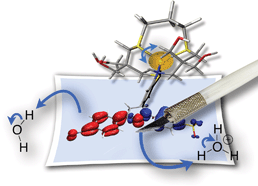Cu(I)-responsive fluorescent probes based on a photoinduced electron transfer (PET) mechanism generally show incomplete fluorescence recovery relative to the intrinsic quantum yield of the fluorescence reporter. Previous studies on probes with an N-aryl thiazacrown Cu(I)-receptor revealed that the recovery is compromised by incomplete Cu(I)–N coordination and resultant ternary complex formation with solvent molecules. Building upon a strategy that successfully increased the fluorescence contrast and quantum yield of Cu(I) probes in methanol, we integrated the arylamine PET donor into the backbone of a hydrophilic thiazacrown ligand with a sulfonated triarylpyrazoline as a water-soluble fluorescence reporter. This approach was not only expected to disfavor ternary complex formation in aqueous solution but also to maximize PET switching through a synergistic Cu(I)-induced conformational change. The resulting water-soluble probe 1 gave a strong 57-fold fluorescence enhancement upon saturation with Cu(I) with high selectivity over other cations, including Cu(II), Hg(II), and Cd(II); however, the recovery quantum yield did not improve over probes with the original N-aryl thiazacrown design. Concluding from detailed photophysical data, including responses to acidification, solvent isotope effects, quantum yields, and time-resolved fluorescence decay profiles, the fluorescence contrast of 1 is compromised by inadequate coordination of Cu(I) to the weakly basic arylamine nitrogen of the PET donor and by fluorescence quenching via two distinct excited state proton transfer pathways operating under neutral and acidic conditions.

You have access to this article
 Please wait while we load your content...
Something went wrong. Try again?
Please wait while we load your content...
Something went wrong. Try again?


 Please wait while we load your content...
Please wait while we load your content...